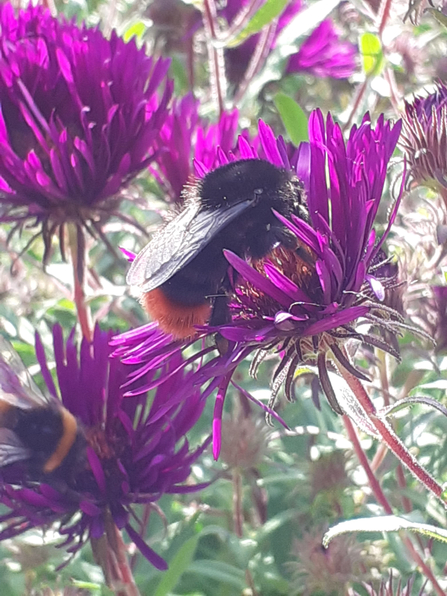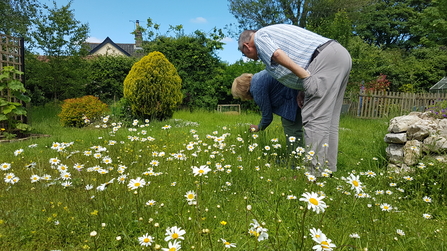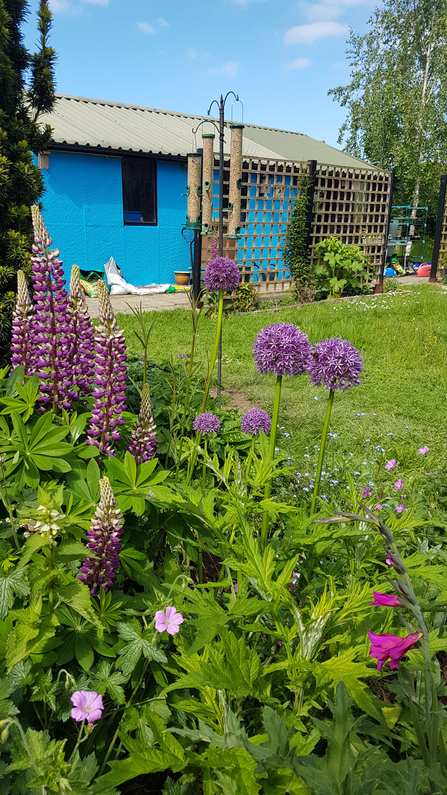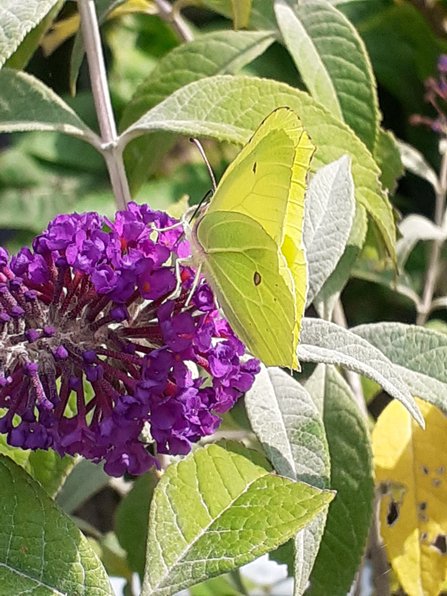My first impressions are of a cared for garden, not entirely a wilderness. A perennial border has been planted with flowers selected for their pollinator benefits: Nepeta, Scabiosa atropurpurea, verbena, hardy geraniums, alliums, Cirsium rivulare make a colourful display and, as if to demonstrate their worth, bumblebees and hoverflies forage amongst them.
An extraordinary but ordinary garden

Bumblebee - Kate Burchell
Just beyond, a new wildflower meadow is taking shape, yellow rattle to stem the vigour of grass, red clover and bird’s foot trefoil along with ox eye daisies - an immediate crowd pleaser.
Crafted from hard work, a wildlife pond is establishing, with shallow edges for pond plants and to allow bathing by birds and to give hedgehogs a safe exit. Kathryn describes how the dished surface of a rock creates a shallow pool ideal for bumblebees to drink from, this attention to detail is evident throughout the garden.

Kate and Dave's wildflower meadow - Cathy Smith
When it comes to solitary bee homes, observing which bee homes are occupied has helped understand the preferences of different species and to tailor the homes to be the most desirable residencies possible. I listen attentively as Dave explains that the hairy footed flower bees and red mason bees choose larger 7mm holes, carpenter bees select the smaller 3.5mm diameter holes and that bamboo canes and softwood is shunned for hard wood as it doesn’t splinter.
When it comes to homes, the birds sometimes have different ideas to our own. Wrens took up residence in a bat box, mandarin ducks in the barn owl box and house sparrows in the swift box! All happily accommodated if not quite as intended.

Garden flower border - Cathy Smith
Hedgehogs are regular visitors, thankfully feasting on the kitten biscuits, and apparently somewhat less impressed by the proprietary hedgehog food. Along with other village residents, Kate’s garden is a great place to be a hedgehog - a long pile, native hedges with a good dense base and long grasses, permeable boundaries and with an absence of pesticide use.
Bird feeders decorate a small tree within sight of the window and with binoculars at the ready, Kate has recorded 45 bird species in the four years or so of living here. She recounts how on one occasion a flock of field fares descended in noisy fashion to feast on the crab apples on two young trees, remaining there until the last was eaten.

Brimstone - Kate Burchill
A shining light as a community champion too, Kate writes the Nature Notes for her village newsletter, linked the Primary School with Suffolk Swift Group to get swift boxes put up and is working with other residents to help survey and manage the churchyard. A contributor to the newly formed village conservation and wildlife group, wildlife is certainly getting a helping hand in this village.
Their take-home message for me is that you notice more in your garden than when out for a walk even in a nature reserve, simply because you spend more time there, you aren’t just passing through. Everything seems a delight, from the scurrying of a bank vole and bumbling sexton beetles to watching bats at dusk.
Find out how your garden measures up and how to make a difference for Suffolk’s wildlife where you live:
Wildlife Gardening Survey | The Wildlife Trusts
